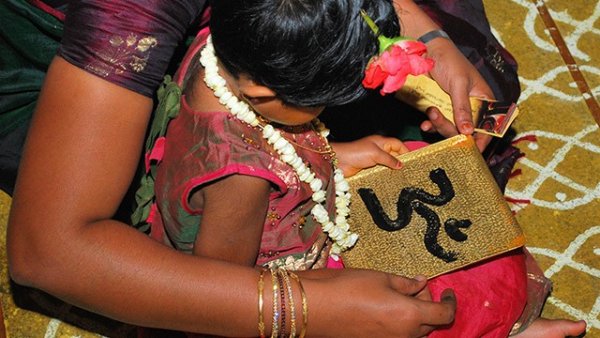P.J.
0
Vidyāraṃbhaṃ
The ritual of Vidyarambham introduces young children into the world of knowledge, letters, and the process of learning.

Vidyarambham (Malayalam: വിദ്യാരംഭം) is a Hindu tradition observed onVijayadashami day mainly in Kerala and Karnataka, where children are formally introduced to music, dance, languages and other folk arts. It involves a ceremony of initiation into the characters of the syllabary.
The Vijayadashami day is the tenth and final day of the Navratri celebrations, and is considered auspicious for beginning learning in any field. The process of learning and initiation on this day is also closely related to the Ayudha Pujaritual. It is usually on Vijayadashami that the implements kept for puja are taken up again for re-use. This is also considered a day when the Goddess of learning, Saraswati, and teachers (gurus) must be revered by givingGurudakshina. This usually consists of a betel leaf, Areca nut, along with a small token of money and a new piece of clothing - a dhoti, mundu or saree.
The ceremony of Vidyarambham (Vidya means "knowledge", arambham means "beginning') for children is held in temples and in houses. It is common practise for thousands of people to visit temples to initiate their children into learning.
Initiation into the world of syllabary usually begins with the writing of themantra
which means
Initially, the mantra is written on sand or in a tray of rice grains by the child, under the supervision of a master who conducts the ceremony (usually a priest or a guru). Then, the master writes the mantra on the child's tongue with gold. Writing on sand denotes practice. Writing on grains denotes the acquisition of knowledge, which leads to prosperity. Writing on the tongue with gold invokes the grace of the Goddess of Learning, by which one attains the wealth of true knowledge. The ritual also involves an invocation to Lord Ganapathy for an auspicious start to the learning process.
Nowadays, the Vidyarambham ceremony is celebrated by people across all castes and religions, with small variations in the rituals followed. The ritual is especially seen in many churches across Kerala, apart from the temples
https://en.wikipedia.org/wiki/Vidyāraṃbhaṃ
https://www.boddunan.com/articles/p...idyarambham-when-a-child-starts-learning.html
The ritual of Vidyarambham introduces young children into the world of knowledge, letters, and the process of learning.

Vidyarambham (Malayalam: വിദ്യാരംഭം) is a Hindu tradition observed onVijayadashami day mainly in Kerala and Karnataka, where children are formally introduced to music, dance, languages and other folk arts. It involves a ceremony of initiation into the characters of the syllabary.
The Vijayadashami day is the tenth and final day of the Navratri celebrations, and is considered auspicious for beginning learning in any field. The process of learning and initiation on this day is also closely related to the Ayudha Pujaritual. It is usually on Vijayadashami that the implements kept for puja are taken up again for re-use. This is also considered a day when the Goddess of learning, Saraswati, and teachers (gurus) must be revered by givingGurudakshina. This usually consists of a betel leaf, Areca nut, along with a small token of money and a new piece of clothing - a dhoti, mundu or saree.
The ceremony of Vidyarambham (Vidya means "knowledge", arambham means "beginning') for children is held in temples and in houses. It is common practise for thousands of people to visit temples to initiate their children into learning.
Initiation into the world of syllabary usually begins with the writing of themantra
| “ | "Om hari sri ganapataye namah"(ഓം ഹരിഃ ശ്രീ ഗണപതയേ നമഃ) | ” |
| “ | Salutations to Hari (Lord Vishnu), Shree (the Goddess of prosperity), and Lord Ganapathy | ” |
Nowadays, the Vidyarambham ceremony is celebrated by people across all castes and religions, with small variations in the rituals followed. The ritual is especially seen in many churches across Kerala, apart from the temples
https://en.wikipedia.org/wiki/Vidyāraṃbhaṃ
https://www.boddunan.com/articles/p...idyarambham-when-a-child-starts-learning.html
